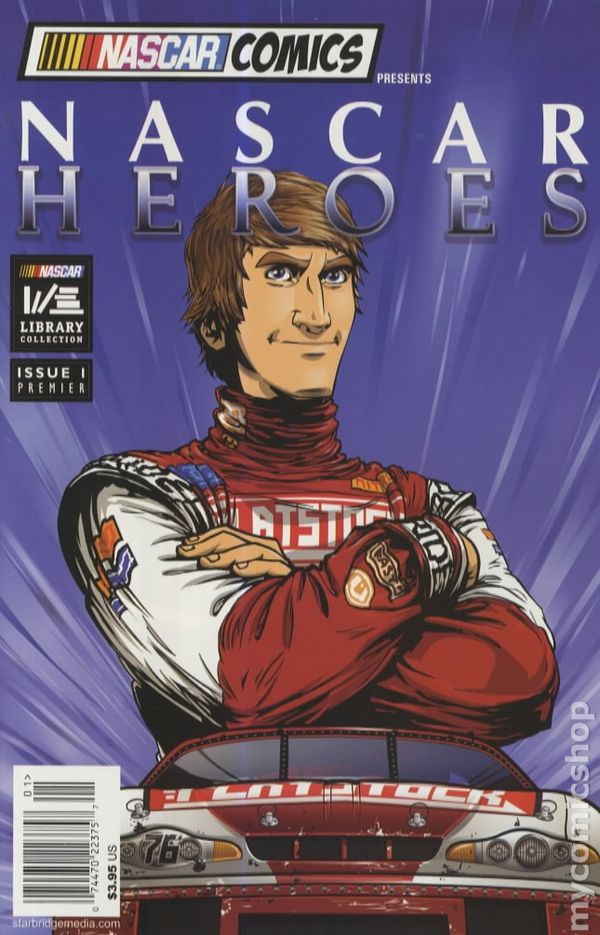“I just wanted that gorgeous, aggressive artwork…” – Sam Bayer, Head Chief Emeritus of All Time Comics
“At All Time Comics, we invite you to rejoice in the sensation of immediacy. We don’t want you to feel the computer, we want you to feel the blood pumping through the creator’s hand” – Josh Bayer and Josh Simmons

I.
It’s hand-lettered. It’s printed on pulpy, toothy paper. The color doesn’t scream Photoshop—in fact, the coloring palettes and styles resonate with periods from past decades in comics. Don’t ask me how they did it. I don’t wanna know. I’m just glad to see a comic book that looks like the gloriously garish trash I grew up reading.
All Time Comics is a (relatively) new full-color superhero floppy comic book series. It’s a petri dish of vibrant work from long-time industry powerhouses stirred in with zesty comics by younger alternative cartoonists. It’s a go-for-broke fever dream that makes as much sense as a building-sized Kirby machine. It’s a crazy-ass conceit and it’s fun as hell.

II.
This is a little embarrassing but I’ve been thinking a lot about Bullwhip’s butt.
All Time superhero Bullwhip’s costume includes a skintight purple high-cut leotard, long black dominatrix boots and, of course, a whip. Her glutes are round melons so firm you could bounce slabbed silver age comics off them (in fairness, the same applies to the butts of some of the male heroes in this universe). Bullwhip might turn a few heads in lust, but she has integrity and rightousness. A fierce feminist, her arch enemy is a middle-aged, beer-gutted, velour-running-suit-clad, woman-hating man called—well, he’s called The Misogynist. I’m thinking nuance is not the goal, here.
In Bullwhip #1 (2017) our heroine is penciled by Benjamin Marra (his style is a love child of Paul Gulacy and Steranko when he was inking S.H.I.E.L.D. stories penciled by Kirby in the pages of those late 1960s issues of Strange Tales) and inked by Al Milgrom. In this story, Bullwhip’s butt is never shown in a gratuitous rump shot, but she’s hot enough to make one consider licking her boots and begging for the fierce authority of her whip.
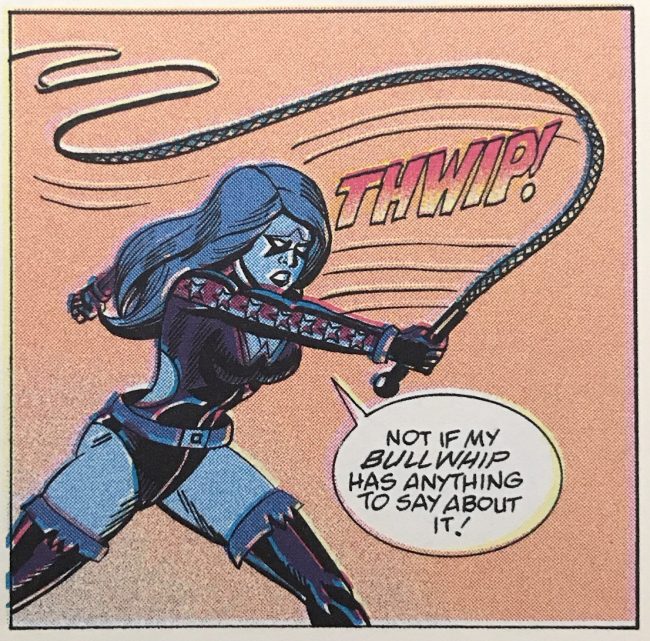
Coming to prominence in the last few years with gonzo books like The Terror Assaulter (O.M.W.O.T) Marra’s comics are at once a celebration and a send-up of adolescent male power fantasies. Paul Constant, co-founder and editor of The Seattle Review of Books (a champion of comics worth your attention), observed that Mara’s Terror Assaulter, “might just be an exercise in nihilism and narrative chaos” and opined that, “the thing is, no matter how you read it ― as a narrative with more to deliver, as a satire of bad comics, as an exercise in emphasizing ugliness ― OMWOT succeeds.” Indeed, the same can be said of All Time Comics – or at least some of it. Different artists have different agendas.
In Bullwhip’s second appearance, in All Time Comics: Zerosis Deathscape #4 (2019), alt cartoonist Julia Gfrörer (Laid Waste, Black is the Color) makes the heroine’s butt the focal point on the splash page. It’s sexy but it is also shaped like a real butt with a kind of flatness and slight sag.
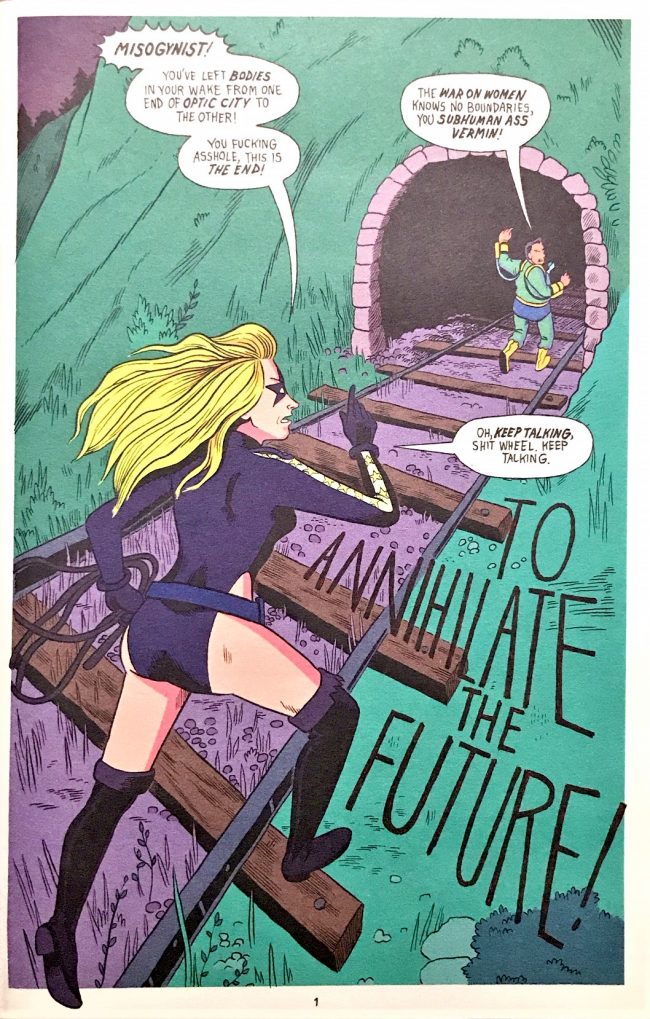
There are other notable changes, too. Bullwhip’s hair has morphed from a lush purple doo into a disheveled mess of blonde tresses; more like what long hair actually looks like if you run around, fight, and get all sweaty and dirty. Her boots are flat heels instead of three-inch heels (so much more practical for chasing down assholes and whipping the crap out of them) and they rise just above the knees, instead of halfway up the thigh as drawn by Marra. It’s like this for the first nine pages of Zerosis Deathscape #4, with pencils by Gfrörer and inks by Josh Simmons (you need a scorecard to read this comic!) And then you turn the page and the world shifts on its axis.

Now Bullwhip is presented in a second splash. It’s a two-page spread and drawn with furious energy by Trevor Von Eden, master of the dynamic layout from the early eighties to now (Batman Annual #8, Thriller #1, Black Lightning, Power Man and Iron Fist). Here, Bullwhip is also shown from the rear in a hyperfeminine fantasy counterpoint to Gfrörer’s splash. Her boots are back to stiletto heels and her hair is now a flowing orange mane. Bullwhip’s bra size has inflated by at least two letters. And her butt is the stuff of adolescent (or R. Crumb’s) fantasy: big and round, with the purple leotard pulled between her cheeks in a narrow v-shape.
Bullwhip’s bottom inflates and deflates, according to the agenda of the artists drawing her. Dare I say this is pretty cheeky of the All Time Comics editors? What’s exposed, aside from posterior muscles, is the tension between the old guard superhero cartoonists and the newer alternative comics folks. One might say there exists a cleft between the two industry branches that is defined not so much by superhero vs. non-superhero, but instead the worldviews and sensibilities of different generations. Plus, back in 1980, there was nowhere near the numbers of women cartoonists that we see in 2020.
In a recent YouTube video, Noah Van Sciver (who penciled an entire ATC book, Crime Destroyer #2) talks about being an alternative comic artist in 2014:
“I was obviously very bitter about being an alternative cartoonist who had to go to superhero conventions all the time where I didn’t fit in … I was looked down upon by the people walking around in their superhero costumes.”
Van Sciver is typically mocking himself in this comment, but I sense a grain of truth. In All Time Comics, the alts and the supers team-up and the result is a conversation on paper between different generations, different approaches, different worlds. It’s not entirely unlike the classic Marvel team-ups when the heroes argue with each other as they kick the crap out of Dr. Doom.
III.
Ever hear of The Rock Bottom Remainders? It’s a band, sort of. A loose affiliation of well-known authors assemble once a year and play music in front of people. Original group members include Stephen King, Amy Tan, Dave Barry, Barbara Kingsolver, Greil Marcus, and Matt Groening. Once, Warren Zevon joined them and classed up the act. The “band” is rationalized as a publicity generator but none of these writers need the publicity. One gets the idea they simply dig hangin’ out with other writers and havin’ some fun. Well, that’s probably a good way to look at the two seasons of All Time Comics.
Josh Bayer, who co-founded the series with his brother Sam and co-wrote Zerosis Deathscape with Simmons (as well as contributing some fascinatingly stylized art), commented on the series by drawing a parallel with another band having fun: “These comics aren’t designed to reform or resurrect the face of superhero comics. These books aren’t gonna be the first Ramones album. They’re more like the ‘Acid Easters’ album they made in the late 80s. It’s the Ramones checking out what they sound like when they play Eric Burden songs or Pete Townsend and Beach Boys songs.”
So what does it look like when cartoonists who don’t normally pen superhero comics team up with other artists who have had long careers working on superhero books? The answer is All Time Comics.

The first series of six books from 2017-18 is collected into a trade paper edition (titled All Time Comics) published by Floating World Comics. In this run, industry stalwarts Al Milgrom (Secret Wars II), Rick Parker (Beavis and Butthead), and Herb Trimpe (The Incredible Hulk, X-Men) collaborate with younger independent cartoonists including co-creator Josh Bayer (Theth), Benjamin Marra (Terror Assaulter), and Noah Van Sciver (Fante Bukowski).

This first run debuts four new comic book titles, all named for their stars: Crime Destroyer #1 and #2, Bullwhip #1, Atlas #1, and Blind Justice #1 and #2. Mimicking traditional superhero comics, the books offer minimal character development and loads of action laced with angst, anger, and explosions. Overall, one senses a feverish go-for-broke level of commitment to the series.
ATC is unavoidably meta in the sense that the writers and artists are well aware they are slotting themselves into a long-established, clichéd form. However, once they are into it, they are into it. Like a party of talented musicians working their way through the Jimi Hendrix songbook and a case of cheap beer, the All Time creators are clearly having a ball.
Admittedly, what the publisher, writers, artists, colorists, and letterers manage to pull off is impressive for this day and age. Speaking as someone who spent years of my youth attempting to write and draw superhero comics, I can testify to the fact it ain’t as easy it as it looks – at least not for us mere mortals. Superhero comics may not be your bag or it might be all you read. In either case, you can’t deny the craft required to make the things.
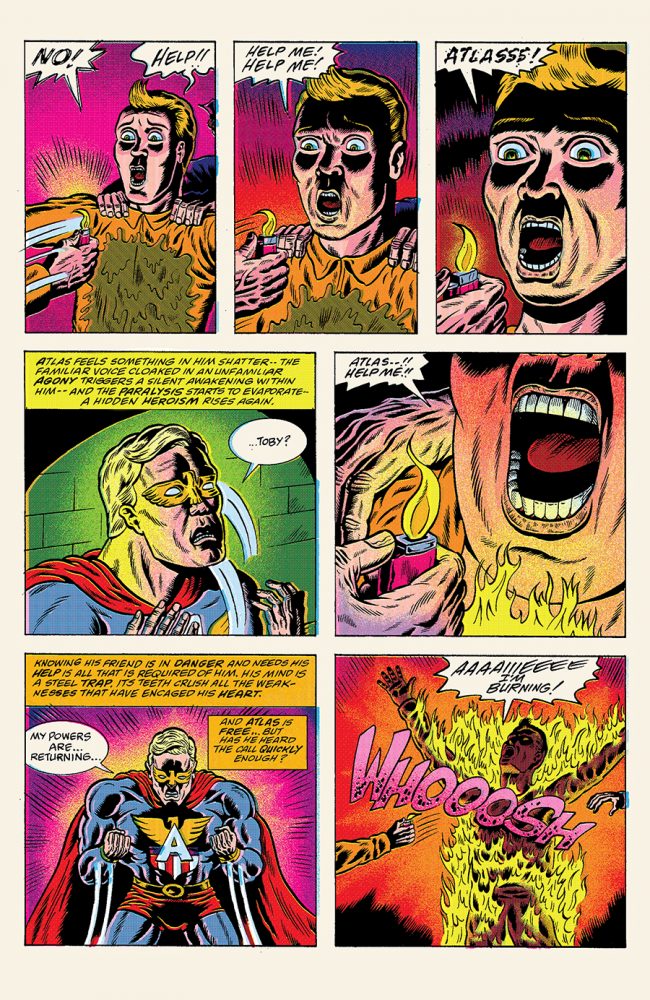
In any case, I find much to enjoy in season one of this series. For example, I really enjoy seeing Benjamin Marra (co-writer with Josh Bayer on most of these issues) lay down a fight scene with Baroque detailing. In Blind Justice #2, Noah Van Sciver’s pencils inked by Al Milgrom and colored by Paul Lyons and Jason T. Miles have a murky menace that I can dig. And I cannot deny the odd pleasure I get from seeing brand spanking new comics that look like the stuff I bought off the spinner racks in the 1970s and 80s.
III.
With Zerosis Deathscape, “season two” of the series, the All Time heroes are brought together into an epic battle that lumbers across seven issues numbered zero through six, with zero being an overture and introduction of Josh Simmons into the mix as a major player. The concept is somewhat like Secret Wars, Crisis on Infinite Earths, or—going way back to the 1940s—the book-length adventures featuring Superman, Batman, Wonder Woman, and others found in All Star Comics. Note the similarity between the two titles—All Star Comics and All Time Comics—a resonance that is almost certainly intentional.
In fact, although the overall look and feel of the comic books evoke the 1980s (remember Baxter paper, anyone?), the content chimes with all epochs of American superhero comics (and even some of the 1950s monster comics, too). While parts of the series have hints of modernist irony, other parts feel like the gung-ho 1940s comics.

In fact, one of the new season two heroes, the Red Maniac—a fat, not too bright guy in red long johns with a bucket over his head—is a dead ringer for an actual Golden Age superhero: the Red Tornado. Anyone schooled in comics history will appreciate the reference to one of the better—if obscure—comics of the 1940s, Scribbly, although it’s not actually a superhero series.
The Red Tornado is the hero identity of Ma Hunkel, a Jewish mother who had been appearing in Mayer’s Scribbly comics stories for a couple of years. Inspired by her son’s tales of D.C. comic book superheroes, she dons red longjohns and a bucket she debuts as the Red Tornado in a June 1939 issue of All-American Comics (there’s that echoing title again). A case could be made for Ma Hunkel being the first woman superhero.
Mayer, then an editor for National (later D.C.) was instrumental in getting Superman published after pretty much every other publisher in the world had rejected the character. I’ve always wondered if Mayer gave Jerry Siegel and Joe Shuster’s concept a try because he had the idea to satirize it and you can’t lampoon something that isn’t first brought into existence. In any case, the comic book superhero and the comic book parody of the comic book superhero appear in the culture at virtually the same moment and the two approaches have been locked in mortal combat ever since.
In the ATC universe, you can decide to become a superhero and, if you have enough grit and an unhealthy amount of ego, you can. No need for a radioactive spider to bite you. (Although one ATC villain, Rain God, is created while being executed in an electric chair.)
If I found the first run of stories convoluted with rhythms that are somewhat hard to follow, the new Zerosis Deathscape series is equally labyrinthine, but I’m happy to say the storytelling is more accessible to me. This may be a contribution of Josh Simmons, who scripted the first drafts of the stories based on conferences with Josh Bayer, who then made edits and revisions.
As anyone who has read Simmons’s comics knows, his narratives are as well-constructed as a house. His first published book-length story, which happens to be named House, has no words and yet flows smoothly and logically with character development and drama, even when fantastic things happen. While Zerosis Deathscape is less controlled, the overall framing is pretty solid. And it shows another side to Simmons, one that is surprisingly humorous (which leads to a different reading of his horror comics).
Prior to joining the All Time bullpen, Josh Simmons dipped his toe into superhero waters when he wrote and drew "Mark of the Bat," a terrifically creepy and funny unauthorized Batman story that appears in his 2012 collection The Furry Trap. He followed it up in 2017 by writing a second unauthorized Batman story, Twilight of the Bat. The comic is drawn by Pat Keck (who contributes marvelous art to the inside front and back covers of Zerosis Deathscape -- seek out Keck's self-published illustrated edition of Bram Stoker's Dracula) and was published by Cold Cube Press (see Joe McCulloch's TCJ essay here). Twilight of the Bat stands in my mind as one of the best Batman stories ever. If the executives at D.C. had any balls, they'd buy the comic, publish it under their own brand, and hire Simmons and Keck to make more.
One senses Simmons is having as much fun as the folks who worked on the first run. This time there is more obvious tongue-in-cheek in the writing, although it thankfully doesn’t come across as a lampoon so much as the usual transgressive writing Simmons tends to deliver. Consider this dialogue between supervillain The Beggar and the brutish Batman-like hero Blind Justice (who regularly escapes from his ward in a cranial trauma victims’ inpatient facility to go into the world somewhat like a superhero version of Milt Gross’s 1930s newspaper nut, Count Screwloose):
Blind Justice: I’m going to stop you.
The Beggar: What are you going to do? Bop me on the head? Drop me off in front of the police station? Then what? They lock me up? If you’re lucky. If you can get anything connected to me. I’m too fluid for that. Too fluid for you. I’m a shot of mercury jizz from the pain god’s sweet tip, shooting through these streets, splashing up against any and all I encounter.
Blind Justice: I’m the rubber that’s going to wrap you up tight and keep you from infecting more any more innocents. I’m the condom of –
The Beggar: Justice. Yes, I know.
A panel later, Blind Justice grimly, if incoherently, retorts through his duct tape (or Jack Pierce mummy bandages, depending on who pencils the story) mask: “My destiny is to defeat what is rotten and corrupt in this world and your story is already written: the one true book in an illiterate cosmos.” This all reads like Denny O’Neil on meth.
The main artist of the Zerosis Deathscape series is Trevor Von Eden, who delivers a satisfying pile of pages that careen and zoom in his typical mind-boggling layouts.

IV.
Consider Issue One of All-Time Comics: Zerosis Deathscape: a 32-page story in which the first seven pages are drawn by forty-four-year-old alternative cartoonist Gabrielle Bell and the remaining 25 pages are drawn by sixty-year-old D.C. and Marvel superhero specialist Trevor Von Eden The story itself is about the passing of the torch across successive generations. In issue zero, a picked-upon orphan boy is saved (sort of) by the Red Maniac. In issue one, that kid has grown up years later to be a beat cop who saves a victimized orphan boy and passes on the torch of a precious Red Manic Snack Pack©. And so it goes, with superheroes, and with cartoonists.

On the surface, All Time Comics is an action-packed tribute to the superhero. Underneath the surface, the series curiously prowls the subterranean Tunnels of Culture that connect cartoonists of vastly different eras, styles, and sensibilities. I think it’s safe to say the impetus for the series is an unapologetic love of comics—all comics of, well, all time.
The trade paper edition of the first season of All Time Comics and the individual comic book issues of All Time Comics: Zerosis Deathscape are currently available from Floating World Comics and the usual outlets. Zerosis Deathscape will be collected into a trade paper edition, presumably with extra goodies, and is scheduled to be released this coming August.
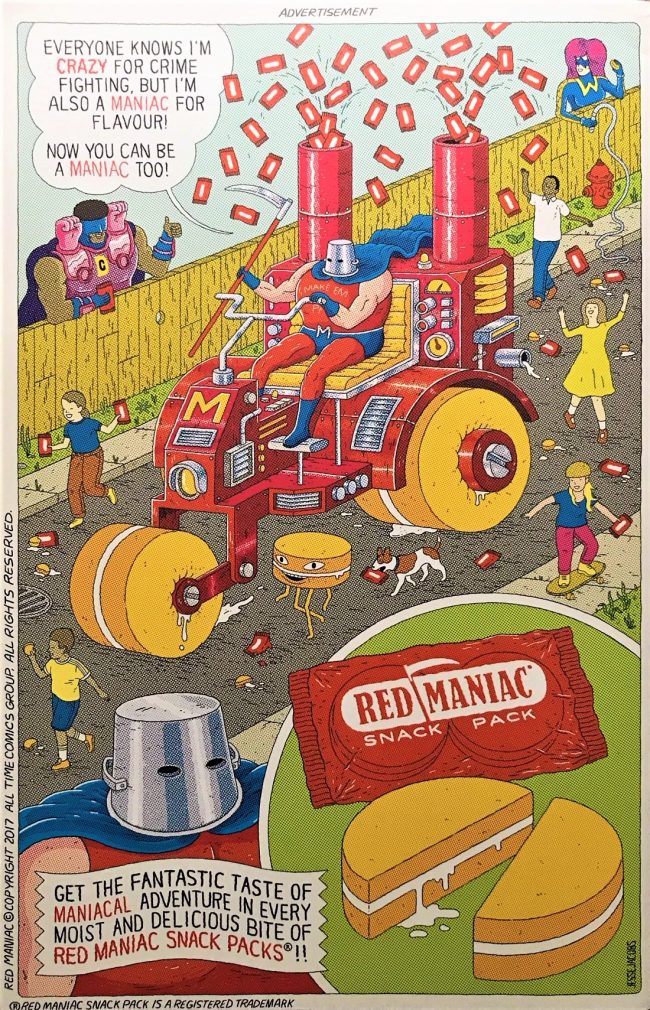
____________
Paul C. Tumey is a writer, designer, and comics historian living in Seattle, Washington. His book, Screwball! The Cartoonists Who Made the Funnies Funny (IDW Library of American Comics) has been nominated for a 2020 Eisner Award.



